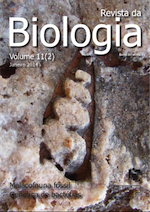Relationship analysis of Yersinia pestis strains isolated during the epidemic focus of Araripe, Pernambuco, Brazil, by MLVA
DOI:
https://doi.org/10.7594/revbio.11.02.02Keywords:
MLVA, plague, VNTR.Abstract
A set of twenty strains of Yersinia pestis isolated during the investigation of an outbreak in a focus of the Araripe, municipality of Exu, state of Pernambuco, Brazil, was analyzed for six VNTR (variable number of tandem repeats) loci. The strains, conserved in the bacterioteca SRP (bacterial collection of the Reference Service in Plague), were reactivated and the identification confirmed by bacteriological bacteriophage susceptibility to anti-plague. Changes in the genome were screened for the presence or absence of virulence genes in plasmids prototypical Y. pestis and High-Pathogenicity Island (HPI) of yersinias by multiplex-PCR. The strains proved to be genetically related by MLVA (analysis of multiple loci of variable number of tandem repeats), which reflects the epidemiological relationship of these isolates.Downloads
Download data is not yet available.
Downloads
Published
2018-04-23
Issue
Section
Artigo
License
We ensure that our journal does not retain any copyright and that these are exclusive of the author(s) of the text. In that sense, we intend to break any restrictions to the published material and to achieve more intensely our goal of communicating science.
How to Cite
Pessoa Junior, M. E., Souza, G. T. de, Santos, S., Balbino, T. C. L., Leal, N. C., Oliveira, M. B. M. de, & Almeida, A. M. P. de. (2018). Relationship analysis of Yersinia pestis strains isolated during the epidemic focus of Araripe, Pernambuco, Brazil, by MLVA. Revista Da Biologia, 11(2), 7-13. https://doi.org/10.7594/revbio.11.02.02






